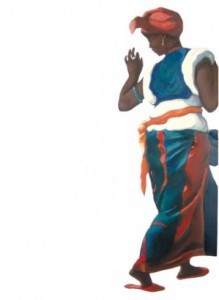ERACE-ING ART HISTORY
Titus Kaphar’s “Visual Quotations” series is comprised of meticulously crafted paintings deriving from the portrayal of black people in 18th and 19th century Western painting. The original paintings, by artists such as Copley, Delacroix, Blake, and Eakins, were selected for their relevance within the “canon” of Western art history, and for the compositional theme of black and white people portrayed in close proximity. In each painting Kaphar has removed from the composition all white figures and all remnants of the original painted environment. What remains is the black figure on a white ground, in compositional isolation.
Each large painting is accompanied by a smaller reproduction of the original that depicts everything except the black figure. The empty space left by the figures makes visible their role in the original composition while commenting on the marginalized nature of black figures in the western canon. Through isolating the black figures in a separate, larger painting, Kaphar suggests that these marginalized figures are worth our attention, that visual representations have a cultural and political significance.
The exhibition was on display March 19, 2004 – May 30, 2004.
BOOKS
Race-ing Art History: Critical Readings in Race and Art History
Kimberly N. Pinder, ed.
Collection of essays that discuss racial visibility and politics in the study of art history and contemporary art.
The Black Presence in the Era of the American Revolution
Sidney and Emma Nogrady Kaplan
Discusses the military, economic, political and cultural lives of African Americans during the American Revolution.
Facing History: The Black Image in American Art 1710-1940
Guy C. McElroy
Examines the changing representation of African Americans in American art and analyzes the way these shifts reflect wider social and political changes.
With Other Eyes: Looking at Race and Gender in Visual Culture
Lisa Bloom, ed.
Collection of essays that harness feminist, postcolonial and anti-racist theory to analyze visual culture.
WEBSITES
ART
Kara Walker
Walker uses silhouettes, reminiscent of those popular in the 18th and 19th century, to approach racial and sexual violence in American history especially as it relates to slavery and the antebellum South. The stark black and white of the silhouettes mirrors the reductive nature of stereotypes and their connection to the emotionally and politically charged issue of race in America.
Fred Wilson
Wilson’s work focuses on the political and cultural significance of historic artifacts and museum display, to analyze what gets brushed aside when history is constructed and presented in museum settings. His museum interventions compel viewers to reconsider their relationship to history and to the institutions that control our remembrance of the past.
Sins of Omission: Fred Wilson’s Mining the Museum
Judith E. Stein
A look back at Wilson’s 1992 exhibit at the Maryland Historical Society


